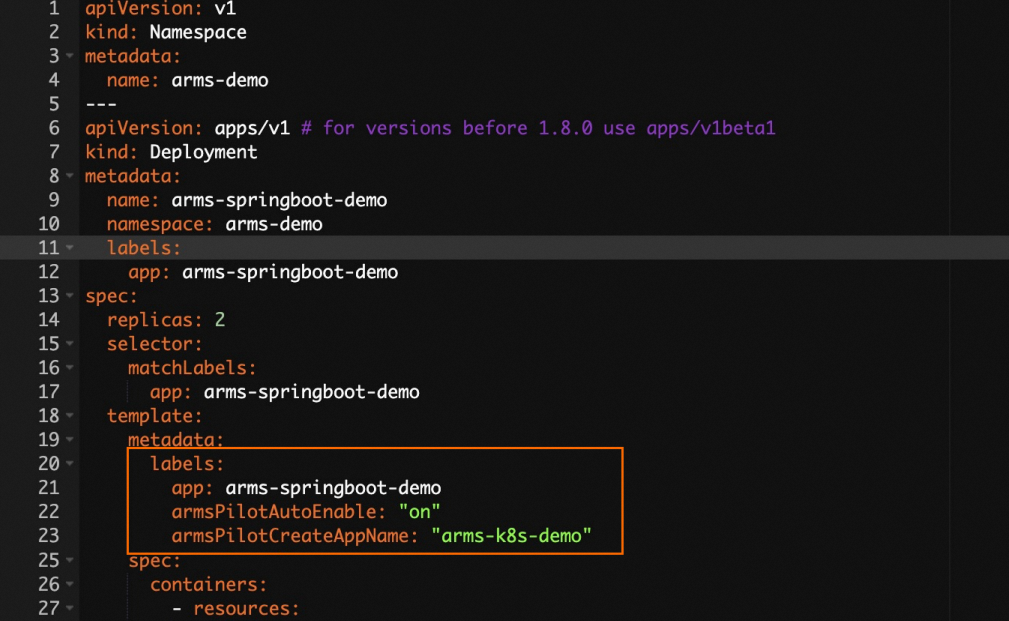Application Real-Time Monitoring Service (ARMS) を使用して、アプリケーションのステータスをリアルタイムで監視できます。 登録済みクラスター内のアプリケーションを監視するには、登録済みクラスターにARMSアプリケーション監視コンポーネントをインストールする必要があります。
前提条件
Container Service for Kubernetes (ACK) コンソールに外部Kubernetesクラスターが登録されています。 詳細については、「ACKコンソールでの登録済みクラスターの作成」および「onectlを使用した登録済みクラスターの作成」をご参照ください。
kubectlクライアントが登録済みクラスターに接続されています。 詳細については、「クラスターのkubeconfigファイルを取得し、kubectlを使用してクラスターに接続する」をご参照ください。
手順1: ARMSアプリケーション監視コンポーネントのインストール
onectlの使用
オンプレミスマシンにonectlをインストールします。 詳細については、「onectlを使用した登録済みクラスターの管理」をご参照ください。
次のコマンドを実行して、ack-onepilotコンポーネントのRAM権限を設定します。
onectl ram-user grant --addon ack-onepilot期待される出力:
Ram policy ack-one-registered-cluster-policy-ack-onepilot granted to ram user **** successfully.次のコマンドを実行して、ack-onepilotコンポーネントをインストールします。
onectl addon install ack-onepilot期待される出力:
Addon ack-onepilot, version **** installed.
コンソールの使用
RAMポリシーを設定します。 コンポーネントをインストールする前に、登録済みクラスターでAccessKeyペアを指定する必要があります。 AccessKeyペアは、クラウドサービスアクセス権限を取得するために使用されます。
RAM ユーザーを作成します。 詳細については、「RAM ユーザーの作成」をご参照ください。
カスタムポリシーを作成します。 詳細については、「カスタムポリシーの作成」をご参照ください。
ack-onepilotコンポーネントには、次のポリシーの権限が必要です。{ "Version": "1", "Statement": [ { "Action": "rds:*", "Resource": "*", "Effect": "Allow" } ] }カスタムポリシーをRAMユーザーにアタッチします。 詳細については、「RAMユーザーの権限付与」をご参照ください。
RAMユーザーのAccessKeyペアを作成します。 詳細については、「AccessKey の作成」をご参照ください。
AccessKeyペアを使用して、登録済みクラスターに
alibaba-addon-Secretという名前のシークレットを作成します。次のコマンドを実行して、
ack-onepilotコンポーネントで使用されるシークレットを作成します。説明コマンドの
access-key-idとaccess-key-secretを、前の手順で作成したAccessKey IDとAccessKey secretに置き換える必要があります。kubectl -n ack-onepilot create secret generic alibaba-addon-secret -- from-literal='access-key-id=<your AccessKey ID>'-- from-literal='access-key-secret=<your AccessKey Secret>'
ack-onepilotコンポーネントをインストールします。ACKコンソールにログインします。 左側のナビゲーションウィンドウで、[クラスター] をクリックします。
[クラスター] ページで、管理するクラスターの名前をクリックします。 左側のナビゲーションウィンドウで、 を選択します。
On theアドオンページをクリックし、ログとモニタリングタブを検索し、ack-onepilotカードをクリックし、インストール右下隅にあります。
では、ack-onepilotをインストールするダイアログボックスでパラメーターを設定し、OK.
手順2: JavaアプリケーションのARMSの有効化
ACKコンソールにログインします。 左側のナビゲーションウィンドウで、[クラスター] をクリックします。 [クラスター] ページで、管理するクラスターを見つけ、[操作] 列の [アプリケーション] をクリックします。
デプロイメントページで、アプリケーションを見つけて選択しますで、アクション列を作成します。
新しいJavaアプリケーションのアプリケーション監視を有効にするには、YAMLから作成する上のデプロイメントページに移動します。
テンプレートコードエディターのspec > template > metadataセクションに次の
ラベルを追加します。labels: armsPilotAutoEnable: "on" armsPilotCreateAppName: "<your-deployment-name>" # Replace <your-deployment-name> with the actual application name. armsSecAutoEnable: "on" # If you want to connect the application to Application Security, you must configure this parameter.説明アプリケーションセキュリティの詳細については、アプリケーションセキュリティとは
アプリケーションセキュリティの課金ルールの詳細については、「課金」をご参照ください。

次のYAMLテンプレートは、配置アプリケーションを作成し、アプリケーションのアプリケーションモニタリングを有効にする方法を示しています。
[デプロイメント] ページで、Javaアプリケーションの [アクション] 列の [ARMSコンソール] をクリックして、ARMSコンソールに移動し、サービスガバナンスを実行します。
次のステップ
クラスター内のすべてのアプリケーションのack-onepilotのアンインストール
onectlの使用
次のコマンドを実行して、ack-onepilotコンポーネントをアンインストールします。
onectl addon uninstall ack-onepilot期待される出力:
Addon ack-onepilot uninstalled.アプリケーションポッドを再起動します。
コンソールの使用
ACKコンソールにログインします。 左側のナビゲーションウィンドウで、[クラスター] をクリックします。
[クラスター] ページで、管理するクラスターの名前をクリックします。 左側のナビゲーションウィンドウで、 を選択します。
On theアドオンページをクリックし、ログとモニタリングタブを検索し、ack-onepilotコンポーネントをクリックし、アンインストール右下隅にあります。
表示されたメッセージボックスで、[OK] をクリックします。
アプリケーションポッドを再起動します。
クラスター内のアプリケーションのack-onepilotのアンインストール